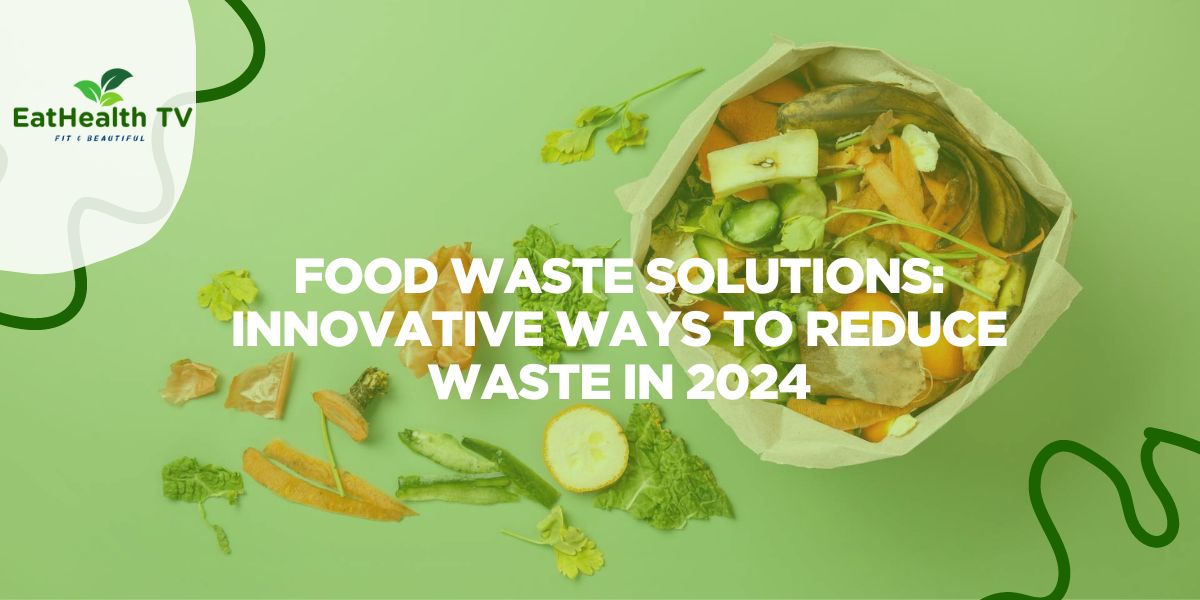Food Waste Solutions: Innovative Ways to Reduce Waste in 2024
Revolutionizing Waste Reduction: Innovative Food Waste Solutions for a Greener 2024
Food Waste Solutions: Innovative Ways to Reduce Waste in 2024

Food waste is a global issue that affects the environment, economies, and society as a whole. In 2024, it remains one of the most pressing challenges, as billions of tons of food are wasted each year, even while millions of people go hungry. The environmental impact of food waste is staggering—landfills, carbon emissions, and water usage are all part of the equation. Fortunately, innovative solutions and technological advancements are paving the way to reduce food waste significantly.
In this post, we will explore the cutting-edge strategies and technologies being used in 2024 to tackle food waste at every stage of the food supply chain, from production to consumption. Whether you’re a business, policymaker, or individual consumer, there’s something here for everyone to help reduce waste and create a more sustainable future.
The Global Impact of Food Waste
Before diving into the innovative solutions of 2024, it’s crucial to understand the scale of the problem. According to the United Nations, approximately one-third of the food produced globally is wasted. This amounts to around 1.3 billion tons of food each year, with a corresponding economic loss of $1 trillion.
Food waste occurs at all stages of the supply chain—during production, storage, transportation, retail, and consumption. Some food never makes it off the farm due to overproduction, cosmetic imperfections, or inefficiencies in the harvesting process. Further down the line, food is wasted during storage and transport due to poor conditions or spoilage. At the consumer level, households often throw away food because of misjudged portion sizes, misunderstood expiration dates, or simply forgetting about it in the back of the fridge.
The environmental impact of food waste is also immense. When food decomposes in landfills, it produces methane, a potent greenhouse gas that contributes to climate change. In addition, producing food requires significant amounts of water, energy, and land, all of which are wasted when food is thrown away.
Emerging Solutions to Reduce Food Waste in 2024
In 2024, the fight against food waste has entered a new phase. Technological innovation, policy changes, and growing consumer awareness are driving significant progress in reducing food waste. Let’s take a closer look at some of the most promising solutions.
1. AI-Powered Supply Chain Management
One of the most significant advancements in reducing food waste in 2024 comes from artificial intelligence (AI). AI-powered systems are now being used to optimize every aspect of the food supply chain, from farm to table.
Farmers and food producers are using AI to predict crop yields more accurately, minimizing the risk of overproduction. By analyzing data such as weather patterns, soil conditions, and historical crop performance, AI algorithms can provide farmers with precise recommendations on when to plant, harvest, and distribute their crops.
Retailers and restaurants are also benefiting from AI-powered inventory management systems. These systems analyze sales data, customer preferences, and other variables to forecast demand more accurately, reducing the likelihood of over-ordering and minimizing food waste. By optimizing inventory levels, businesses can ensure that they have enough food to meet demand without wasting surplus.
2. Smart Packaging Technology
Smart packaging is another innovative solution gaining traction in 2024. Traditional packaging often fails to provide consumers with accurate information about the freshness of food, leading to unnecessary waste. Many consumers throw away perfectly good food because they rely on expiration dates, which are often conservative estimates of when food might go bad.
Smart packaging, however, can monitor the actual condition of food in real-time. Some smart packaging systems use sensors to track temperature, humidity, and gas levels inside the package, providing consumers with more reliable information about the freshness of the product. For example, if the packaging detects that the food has been stored in optimal conditions, it can indicate that the food is still safe to eat, even if the expiration date has passed.
Additionally, smart packaging can be integrated with mobile apps, allowing consumers to receive notifications when food is nearing its peak freshness. This empowers individuals to use food more efficiently and reduce waste in their own kitchens.
3. Food Sharing Apps
In recent years, food sharing apps have become increasingly popular as a way to reduce waste, and by 2024, these platforms are more widespread and effective than ever. These apps connect people with surplus food—whether individuals, businesses, or organizations—with those who need it.
For example, platforms like Too Good To Go, Olio, and Food Rescue allow restaurants, supermarkets, and even individual households to list surplus food that would otherwise go to waste. Users can browse the listings and collect the food at a reduced price or for free. This not only helps reduce food waste but also makes food more affordable and accessible.
In 2024, advancements in AI and machine learning are helping food-sharing apps become even more efficient. These apps can now use algorithms to predict when businesses are likely to have surplus food, streamlining the process of connecting food with those who need it.
4. Upcycling Food Waste
Another innovative trend in 2024 is the rise of upcycled food products. Upcycling refers to the process of transforming food byproducts or surplus food into new, high-quality products. For example, food manufacturers can use fruit and vegetable peels, spent grains from breweries, or coffee grounds to create nutritious snacks, beverages, and other food products.
Upcycling not only reduces food waste but also adds value to ingredients that would otherwise be discarded. It’s a win-win for both businesses and consumers, as it helps reduce the environmental impact of food production while creating new, sustainable food options.
In 2024, many companies are focusing on creating upcycled products that are not only sustainable but also appealing to health-conscious consumers. Brands are marketing these products as eco-friendly and innovative, tapping into the growing demand for sustainable food choices.
5. Food Waste to Energy Solutions
Food waste doesn’t always have to end up in landfills. In 2024, more cities and municipalities are adopting food waste-to-energy solutions as part of their waste management strategies. These systems convert organic waste, including food scraps, into renewable energy.
Anaerobic digestion is one of the most common methods used for this purpose. In this process, microorganisms break down organic waste in the absence of oxygen, producing biogas, which can be used as a renewable energy source. The remaining byproduct, known as digestate, can be used as a nutrient-rich fertilizer for agriculture.
In 2024, more cities are investing in large-scale anaerobic digestion facilities to divert food waste from landfills and create renewable energy. This not only reduces greenhouse gas emissions but also provides a sustainable energy source that can be used to power homes and businesses.
6. Consumer Education and Awareness Campaigns
While technological advancements are crucial in the fight against food waste, consumer behavior remains a key factor. In 2024, there is a growing emphasis on education and awareness campaigns to help individuals reduce waste in their homes.
Many organizations are launching initiatives to teach people how to properly store food, plan meals, and use leftovers creatively. For example, campaigns focus on helping consumers understand the difference between “best before” and “use by” dates, encouraging them to trust their senses rather than throwing away food prematurely.
In addition, schools, workplaces, and community centers are incorporating food waste education into their programs, raising awareness about the environmental and social impact of food waste. By empowering individuals with the knowledge and tools to reduce waste, these campaigns are helping to create a culture of sustainability.
7. Zero-Waste Restaurants and Businesses
In 2024, more restaurants and food businesses are embracing the zero-waste movement, aiming to minimize or eliminate food waste entirely. Zero-waste restaurants focus on using every part of the ingredient, from root to stem, to create meals. They also implement practices such as composting food scraps and donating surplus food to local food banks or charities.
These businesses often work closely with local farmers and suppliers to ensure that they receive the freshest ingredients, reducing the likelihood of food spoilage. Some zero-waste restaurants even grow their own produce on-site, creating a closed-loop system that minimizes waste.
Additionally, businesses across the food industry are adopting sustainable practices, such as using compostable packaging, reducing portion sizes to prevent plate waste, and collaborating with food rescue organizations to distribute surplus food.
Conclusion
In 2024, the fight against food waste has reached new heights, with innovative solutions emerging at every stage of the food supply chain. From AI-powered supply chain management to smart packaging, food-sharing apps, upcycled food products, and food waste-to-energy systems, technology is playing a crucial role in reducing waste and creating a more sustainable future.
At the same time, consumer awareness campaigns, zero-waste businesses, and upcycling initiatives are helping to change behaviors and attitudes toward food waste. The combination of technological advancements and cultural shifts is driving progress toward a world where food is used more efficiently, and waste is minimized.
While there is still much work to be done, the innovations of 2024 offer hope that we can significantly reduce food waste and create a more sustainable and equitable food system for future generations.




